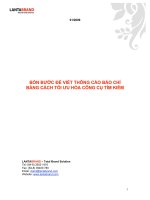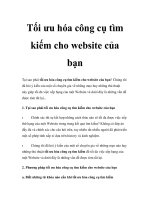Tài liệu Tối ưu hóa công cụ tìm kiếm
Bạn đang xem bản rút gọn của tài liệu. Xem và tải ngay bản đầy đủ của tài liệu tại đây (867.93 KB, 18 trang )
We have a Web site. Now What?
Part 1: On-Page Search Engine Optimization
Practical Advice to Improve Your Online Marketing Eorts
Craig Rentmeester
Introduction 3
The Example: Mayo Clinic – Sore Throat
Google Search Results 4
Google Search Results with explanations 5
On-Page Search Engine Optimization
Content 6
Page Titles 7
URLs 8
Header Tags 9
Link Structure 10
Internal Links 11
Images 12
Keywords Meta Tag 13
Description Meta Tag 14
Sitemaps 15
PDFs 16
Resources 17
Bonus 18
Contents
Introduction
Why do organic search rankings matter?
1. For many people, search engines are the starting point for information on
buying decisions.
2. There are billions of searches down every month and that number is
growing. (Over nine billion searches in August, 2007 – a 28% increase
from August 2006.)
3. It’s tough to buy trafc. According to the search marketing report by Ad
Age published in 2007, the click through rate of search engine
advertisements is 11.5 percent.
Are there also off-page SEO items that I should know about?
Yes, search rankings aren’t just a result of good on-page optimization.
Search rankings also take into account other factors that aren’t directly in
your control. My next e-book will cover off-page SEO items that inuence
search rankings.
Why are there so many links?
This book is written for someone without a strong technical background.
As such, I’ve provided links to any jargon I used throughout the book. If
you’re curious about a term, follow the link for an explanation.
FYI: Links are in green text.
*If you plan to print this document, print it in landscape mode.
This book is intended to empower entrepreneurs. By using this book as a guide, entrepreneurs can expect to see
greater numbers of targeted trafc to their site(s).
By pointing out how the code appears on the
high-ranking web site, I hope it will allow you to
understand the advice more quickly.
To help with the technical learning curve, I’m
providing an example of the search term
“sore throat” and displaying the underlying
source code from the corresponding web page
from MayoClinic.com.
Disclaimer: I am not afliated with Mayo Clinic in any way,
shape or form. Also, MayoClinic.com did have the number one
search ranking on Google for the phrase “sore throat” when this
book was written in January 2008.
/> />Content
The only surere way to great search rankings is to create great, original content. Search engines do not need, nor
do they reward, duplicate content.
Be focused. Try to have a page dedicated to each keyword or phrase that you’re trying to rank well for. Use your
keywords frequently in the body tags of your pages.
While you should include your keywords frequently in the body tags, do not spam a page by placing text in the
same color as the background or hiding keywords in places that people can’t see. This is a way to get banned from
a search engine or be placed in the supplemental index.
Search engines do not properly index Flash hyperlinks or moving text. Try to avoid having ash-based site
navigation and a ash-only homepage.
Avoid using frames because they don’t allow content to be indexed properly in most cases.
Load times are important both for search engines and for visitors. So, avoid using excessive JavaScript.
The phrase “sore throat” appears eight times on the Mayo Clinic page, including the H1 tag. View the cached page.
Page Titles
Page titles are extremely important for both search engine optimization and for click through rate.
Page titles should contain no more than 5 words that are keyword-centric and directly relate to what is on the
corresponding page.
Using more than ve words in a page title dilutes the strength of each word.
Place important keywords early in the page title. The rst word receives the highest reward.
<title>Sore throat - MayoClinic.com</title>









